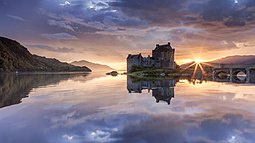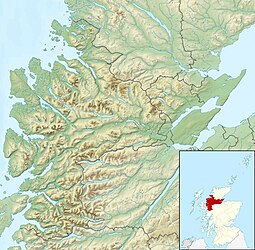Eileen Donan
| Gaelic name | Eilean Donnain |
|---|---|
| Meaning of name | Island of Donnán |
 Eilean Donan Castle |
|
| Location | |
|
Eilean Donan shown within Ross and Cromarty
|
|
| OS grid reference | NG880260 |
| Coordinates | 57°16′N 5°31′W / 57.27°N 5.52°W |
| Physical geography | |
| Island group | Loch Duich |
| Highest elevation | 3 metres (9.8 ft) |
| Administration | |
| Sovereign state | United Kingdom |
| Country | Scotland |
| Council area | Highland |
| Demographics | |
| Population | 0 |
Eilean Donan (Scottish Gaelic: Eilean Donnain) is a small tidal island where three sea lochs meet, Loch Duich, Loch Long and Loch Alsh, in the western Highlands of Scotland. A picturesque castle that frequently appears in photographs, film and television dominates the island, which lies about 1 kilometre (0.62 mi) from the village of Dornie. Since the castle's restoration in the early 20th century, a footbridge has connected the island to the mainland.
Eilean Donan is part of the Kintail National Scenic Area, one of 40 in Scotland. In 2001, the island had a recorded population of just one person, but there were no "usual residents" at the time of the 2011 census.
Eilean Donan, which means simply "island of Donnán", is named after Donnán of Eigg, a Celtic saint martyred in 617. Donnán is said to have established a church on the island, though no trace of this remains.
The castle was founded in the thirteenth century, and became a stronghold of the Clan Mackenzie and their allies the Clan Macrae. In the early eighteenth century, the Mackenzies' involvement in the Jacobite rebellions led in 1719 to the castle's destruction by government ships. Lieutenant-Colonel John Macrae-Gilstrap's twentieth-century reconstruction of the ruins produced the present buildings.
It is possible that an early Christian monastic cell was founded on the island in the 6th or 7th century, dedicated to Donnán of Eigg, an Irish saint who was martyred on Eigg in April 617. No remains of any Christian buildings survive, though fragments of vitrified stone, subjected to very high temperatures, have been discovered indicating the presence of an Iron Age or early medieval fortification.
...
Wikipedia

